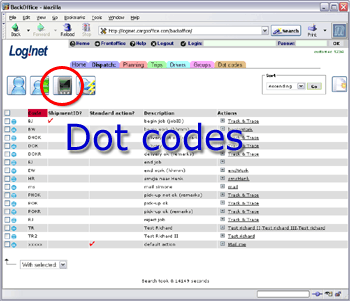Dot Codes
Dot codes are short message codes of max. 5 letters used by drivers to tell the system what he is doing. For instance the code .DELOK might tell the system 'Delivery OK'. Note the dot in front of .DELOK, this is where the name 'dot code' comes from. It tells the system that an instruction follows. It functions as a separator as well so that drivers are able to pack multiple messages in one physical SMS message. Drivers usually send these messages by SMS (phone#: +31653782384) but dot codes can also be send from pda's, smartphones, mobile data terminals, from any internet browser or by EDI (see the EDI section below).See the examples below.
Samples
When a driver sends an SMS message with this content: .BJ 123456 .DT- It could mean: Begin Job 123456; Departure Terminal
- It could mean: Arrival Client; Delivery OK; End Job 123456
EDI
Dot codes can also be send in a file attached to an email or uploaded by FTP.The file must contain a single line with the dot codes, like the examples above.
The filename must have the extension .dot.
The nodeID (driver or truck) must be placed either in the file or in the email address.
When placed in the file it must be added to the end of the line between brackets, like this: .SHIP 123456 .PUPOK (Driver1) When passed in the email address the email address must look something like this: edi+12345.Driver1@cargooffice.com Note: replace 12345 by your carrier number. Also see the paragraph on EDI.
Remarks
- A dot code does nothing more than triggering one or more email messages, called 'actions'.
- The email messages are user definable and might inform persons or systems about the actions of a driver.
- Dot codes are often used to send email messages to the track&trace system to change shipment statuses, but they are also used to report work times, container numbers, trailer ID's or just to send plain email messages.
- Note: Please be aware that sending notifications to other parties are usually shipment related and not driver related, so they do require a shipment status change first.
- The proper sequence to inform other parties is:
- define a dot code, for instance .DELOK (Delivery OK);
- add an 'action' to the dot code to send an email to the track&trace system, changing the status of the shipment into something like 'Shipment Delivered;
- add an action to shipment status 'Shipment Delivered' sending an email to the parties involved.
- For more information about shipment statuses see: About shipment Status.
- If this seems all very confusing to you, then please just remember that 'dot codes' and 'status codes' are different things, 'dot codes' belong to drivers and 'status codes' belong to shipments.
| I | Attachment | History | Action | Size | Date | Who | Comment |
|---|---|---|---|---|---|---|---|
| |
dotcodes_sample.gif | r1 | manage | 28.1 K | 2006-09-27 - 10:37 | RutgerRutgers | sample |
Topic revision: r16 - 2020-06-04 - RutgerRutgers
Ideas, requests, problems regarding TWiki? Send feedback




